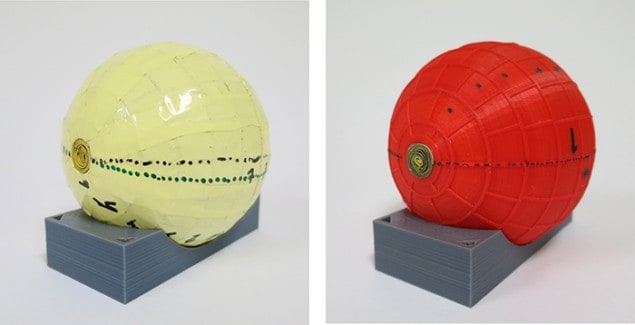
Wormholes are normally the stuff of science fiction, but new research carried out by a group of physicists in Spain has shown that it is possible to build the magnetic equivalent of a wormhole that is capable of transporting a magnetic field from one point in space to another. The team has built a spherical wormhole, made from ferromagnetic and superconducting components, that is magnetically cloaked. The researchers say that the work could prove particularly useful in magnetic resonance imaging.
Wormholes are hypothetical “topological features” or tunnels that, in theory, would connect two distant regions of space–time, via higher dimensions. They are predicted by certain solutions of general relativity, as a result of massive objects severely distorting space–time, but have never been observed in nature and would be exceedingly difficult to recreate in the lab.
Manipulated magnets
In the latest work, Alvaro Sanchez and colleagues at the Autonomous University of Barcelona have instead designed and constructed a wormhole for a magnetic field. The 9 cm-diameter sphere guides and cloaks a magnetic field from a dipole source placed one side of it, such that field lines appear to emanate from a monopole on the other side of the sphere. Indeed, it seems as if the field takes an invisible shortcut through the intervening space. “You see the apparatus with your eyes,” says Sanchez, “but magnetically it is undetectable. It is like the field lines have gone through another spatial dimension.”
The sphere has three parts. Running through it is a tube made from a thin sheet of the nickel–iron ferromagnetic alloy, which is wound into a spiral – it transports the applied field. This “magnetic hose” is needed because magnetic fields decay rapidly with distance – an alternative design for such a hose being realized by Sanchez and co-workers two years ago.
The other two parts then make up the spherical shell: a layer of superconducting tape surrounded by an array of (high-permeability) plates of the alloy. The superconductor repels external magnetic fields, thereby magnetically isolating the hose within; while the array compensates for the fact that the superconductor distorts any external field as it repels it. Designing the array so that it precisely cancels the magnetic signature of the superconductor required extensive computer modelling, notes research co-author Jordi Prat-Camps.
To put its wormhole to the test, the team placed the device in an external magnetic field created by a pair of Helmholtz coils and then inserted magnetic probes at two points – at the exit to the wormhole and alongside it. As intended, the researchers found that the first probe revealed a monopole-like field. The latter, when moved back and forth, showed no distortion of the external field (which was not the case when either of the two shells was removed).
The work builds on a theoretical proposal put forward by Allan Greenleaf of the University of Rochester in the US and colleagues in 2007. Greenleaf’s group actually outlined the design of a wormhole that would apply to electromagnetic waves in general, including light, and not just static magnetic fields. But Sanchez explains that actually building such a device would be extraordinarily difficult – it would require extreme values of magnetic permeability, as well as harder-to-manipulate electrical permittivity. Sanchez points out that the new device is not the world’s first magnetic cloak, but he believes it is the first such cloak to work in three dimensions, rather than two. He also reckons that it is the first ever artificial wormhole of any variety.
Unfortunately, Sanchez does not think that it can help improve our understanding of putative cosmological wormholes. Those objects would rely on the distortion of space–time itself, rather than on a particular field within space–time, and as such would require enormous sources of gravity. “Scientists are very good at manipulating magnetic fields,” he says, “but we don’t have the same mastery over gravitation.”
Manifold magnetic applications
However, the ability to isolate magnetic fields from one another could prove useful in applications such as MRI – potentially allowing simultaneous imaging of different parts of the body. “Our main motivation was scientific,” says Sanchez, “but since magnetic fields are used in so many different things, our device could have many potential applications.”
You see the apparatus with your eyes, but magnetically it is undetectable. It is like the field lines have gone through another spatial dimension
Alvaro Sanchez
Tie Jun Cui, an electrical engineer at Southeast University in China who was not involved in the work, agrees with Sanchez, and believes that it might now be possible to make analogous devices for sound or heat, for example. “Considering the various acoustic-cloak designs proposed in recent years, it should not be difficult to design an invisible acoustic tunnel,” he says.
John Pendry of Imperial College in London, whose technique of transformation optics has been used to develop cloaking devices, notes that there is nothing, in principle, to prevent the magnetic wormhole from working as advertised, but would like further details from the Spanish researchers before endorsing their work. “They don’t give too many details of their design, nor are there any computer simulations to refer to,” he says.
The wormhole is described in Scientific Reports.




